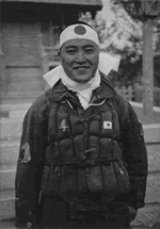
Hachimaki
Encyclopedia
A hachimaki is a stylized headband
(bandana
) in Japanese culture
, usually made of red or white cloth, worn as a symbol of perseverance
or effort by the wearer. These are worn on many occasions, for example, by sports spectators, by women giving birth, students in cram school
, office workers, expert tradesmen taking pride in their work, bōsōzoku
(teen biker gangs) and even rioters. Japanese competitive eater
Takeru Kobayashi
wore a hachimaki for the Nathan's hotdog eating competition.
They are generally decorated with inspirational slogan
s, like 日本一 (Nippon Ichi, "the best of Japan" or "Japan's best"), but most typically with the rising sun
motif.
The historical origin of hachimaki is uncertain. One theory links the cloth to those worn by early religious ascetics. Another theory states that they originated in headbands worn by samurai
that kept their helmets on, to absorb perspiration, and keep hair out of their eyes. "Hachimaki" translates as "helmet-scarf."
Perhaps the most infamous usage of the hachimaki was by the kamikaze
pilots toward the end of World War II
. Kamikaze pilots would frequently don a hachimaki, usually with the kanji
characters 神風 ("Kamikaze") before flying to their deaths.
Headband
A headband is a clothing accessory worn in the hair or around the forehead, usually to hold hair away from the face or eyes. Headbands generally consist of a loop of elastic material or a horseshoe-shaped piece of flexible plastic or metal...
(bandana
Bandana
Bandana can refer to:*Another name for a kerchief*Bandana *Bandana *Bandana, Kentucky, a small town in the United States*Y Bandana, a Welsh alternative rock band.**Y Bandana , their self-titled debut album....
) in Japanese culture
Culture of Japan
The culture of Japan has evolved greatly over the millennia, from the country's prehistoric Jōmon period to its contemporary hybrid culture, which combines influences from Asia, Europe and North America...
, usually made of red or white cloth, worn as a symbol of perseverance
Perseverance
Perseverance may refer to:* Perseverance , a card game* Perseverance , American fighter Brock Lesnar* Perseverance...
or effort by the wearer. These are worn on many occasions, for example, by sports spectators, by women giving birth, students in cram school
Juku
Gakushū juku are special private schools that offer lessons conducted after regular school hours and on the weekends....
, office workers, expert tradesmen taking pride in their work, bōsōzoku
Bosozoku
is a Japanese subculture associated with motorcycle clubs and gangs.-Traits and history:The word bōsōzoku is also applied to motorcycle gangs, who share an interest in modifications for motorcycles, such as removing the mufflers so that more noise is produced...
(teen biker gangs) and even rioters. Japanese competitive eater
Competitive eating
Competitive eating, or speed eating, is a sport in which participants compete against each other to consume large quantities of food in a short time period. Contests are typically less than 15 minutes in length, with the person consuming the most food being declared the winner...
Takeru Kobayashi
Takeru Kobayashi
is a Japanese competitive eater. He held the world record for hot dog eating for nearly six years, and holds several other eating records, including four Guinness Records for hot dogs, meatballs, hamburgers, and pasta....
wore a hachimaki for the Nathan's hotdog eating competition.
They are generally decorated with inspirational slogan
Slogan
A slogan is a memorable motto or phrase used in a political, commercial, religious and other context as a repetitive expression of an idea or purpose. The word slogan is derived from slogorn which was an Anglicisation of the Scottish Gaelic sluagh-ghairm . Slogans vary from the written and the...
s, like 日本一 (Nippon Ichi, "the best of Japan" or "Japan's best"), but most typically with the rising sun
Rising Sun
Rising Sun may refer to sunrise. It may also refer to:-Music:*"Rising Sun" , a song written by Fats Domino* Rising Sun , 2005* Rising Sun , 2010* Rising Sun , 1986...
motif.
The historical origin of hachimaki is uncertain. One theory links the cloth to those worn by early religious ascetics. Another theory states that they originated in headbands worn by samurai
Samurai
is the term for the military nobility of pre-industrial Japan. According to translator William Scott Wilson: "In Chinese, the character 侍 was originally a verb meaning to wait upon or accompany a person in the upper ranks of society, and this is also true of the original term in Japanese, saburau...
that kept their helmets on, to absorb perspiration, and keep hair out of their eyes. "Hachimaki" translates as "helmet-scarf."
Perhaps the most infamous usage of the hachimaki was by the kamikaze
Kamikaze
The were suicide attacks by military aviators from the Empire of Japan against Allied naval vessels in the closing stages of the Pacific campaign of World War II, designed to destroy as many warships as possible....
pilots toward the end of World War II
World War II
World War II, or the Second World War , was a global conflict lasting from 1939 to 1945, involving most of the world's nations—including all of the great powers—eventually forming two opposing military alliances: the Allies and the Axis...
. Kamikaze pilots would frequently don a hachimaki, usually with the kanji
Kanji
Kanji are the adopted logographic Chinese characters hanzi that are used in the modern Japanese writing system along with hiragana , katakana , Indo Arabic numerals, and the occasional use of the Latin alphabet...
characters 神風 ("Kamikaze") before flying to their deaths.

